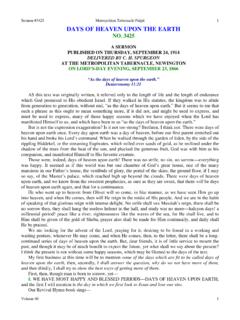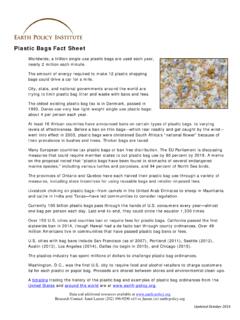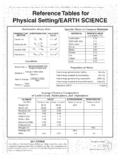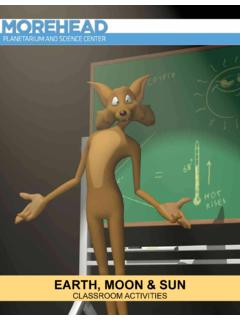Transcription of The Layers of Earth - Virginia Department of Education
1 Science Enhanced Scope and Sequence Grade 5 Virginia Department of Education 2012 1 The Layers of Earth Strand Earth Patterns, Cycles, and Change Topic Investigating Layers of the Earth Primary SOL The student will investigate and understand how Earth s surface is constantly changing. Key concepts include d) the basic structure of Earth s interior. Related SOL The student will investigate and understand how Earth s surface is constantly changing. Key concepts include c) Earth history and fossil evidence. Background Information Scientific evidence indicates that Earth is composed of four concentric Layers crust, mantle, outer core, and inner core each with its own distinct characteristics. The outer two Layers are composed primarily of rocky material. The innermost Layers are composed mostly of iron and nickel. Pressure and temperature increase with depth beneath the surface.
2 The core is the thickest layer of the Earth , and the crust is relatively thin, compared to the other Layers . Materials Modeling clay in different colors Plastic knives or wooden tongue depressors Copies of the attached diagram of the Layers of the Earth Science journals or loose leaf paper Vocabulary crust, mantle, inner core, outer core Student/Teacher Actions (what students and teachers should be doing to facilitate learning) Introduction 1. Ask students what they already know about the structure of the Earth . Review that the Earth consists of three Layers the core (divided into inner and outer), the mantle, and the crust. 2. On the board, draw a picture of the interior of the Earth (see attached diagram of the Layers of the Earth ), and have the students copy it into their science journal or onto loose leaf paper. 3. Explain to students that the inner core is made of very hot metal that takes a solid form, while the outer core is made of molten metal, and that the mantel is made up of hot lava (molten rock) on which the relatively thin layer of crust floats.
3 4. Explain that scientists know the inner and outer core Layers exist because of the seismograms that have been taken during earthquakes. Because the outer core contains iron, when it flows, it generates a magnetic field. This is the source of the Earth s magnetic field. Talk about the mantle, just above the core of the Earth . Explain that the Science Enhanced Scope and Sequence Grade 5 Virginia Department of Education 2012 2 mantle is rather flexible so it flows instead of cracking or breaking up. Explain that the outer layer of the Earth the one we live on is the crust, which is about 25 miles thick beneath the continents and only about miles thick beneath the oceans. The crust is light and brittle compared to the other Layers of the Earth , and most earthquakes occur within the crust. Procedure 1. Hand out the attached diagram of The Layers of the Earth , and ask them if they can think of anything in nature that resembles the Layers of the Earth .
4 Mention a peach as an example. Help them come up with other ideas, such as a hardboiled egg or a plum. 2. Explain to students that they will be creating a model of the Earth s Layers , using different colors of clay. They will be working with a partner. 3. Divide the students into pairs, hand out a small piece of gray clay to each pair, and instruct them to roll it into a small ball. 4. Hand out a piece of green clay, and have them cover the small ball with a uniform thickness of green clay to form a larger ball. 5. Hand out a piece of red clay, which they should use to cover the green with about a inch thickness. 6. Give the students a piece of blue clay that is just enough to cover the red with a very thin coat. 7. Have each pair cut their ball in half. Discuss with the class what each layer of clay represents. Conclusion 1. Have each student label the Layers of the Earth on their diagram in their science journals or loose leaf paper.
5 Have students label each layer with its name and composition. 2. Discuss with the whole class what the relative thicknesses of the Layers are that the inner core and outer core together form the thickest layer of the Earth and that the crust is by far the thinnest layer. 3. Lead students to conclude that the Earth has many Layers and that scientists are aware of these Layers through technology, including the recording of earthquakes with seismographs. Assessment Questions o What is the thickest layer of the Earth ? Explain. o Explain what part of the Earth lies on the crust. Journal/writing prompts o Explain the difference in the inner core and the outer core. o What can the crust be described as when it comes to everyday items and why? Other o Have students draw a diagram of the Layers of the Earth and label them. Science Enhanced Scope and Sequence Grade 5 Virginia Department of Education 2012 3 Extensions and Connections (for all students) Discuss with the class the fact that the crust is not made up of a single piece of rock, but is made up of a series of plates that move and slide along the top layer of the mantle.
6 Have students design the plates on the crust with their plastic knives or tongue depressors. Strategies for Differentiation Provide students with a Layers diagram and have the students describe the Layers in further detail as discussed in class. Students could do a description in article form, infomercial form, or a song. Compare Layers of the Earth to a natural object and describe in detail the similarities and differences of the objects. Have students feel a thin crust, a jelly like mantle, and a hard ball core to compare texture of the Layers for visually challenged. Have the class make a pizza representing the Layers of the Earth , using the toppings to represent each layer. Science Enhanced Scope and Sequence Grade 5 Virginia Department of Education 2012 4 The Layers of the Earth The inner core is made of solid metal.
7 The outer core is made of molten metal. Together, the inner and outer cores form the thickest layer. The mantle is a layer of molten rock. The crust is the thinnest layer. Inner Core Outer CoreMantleCrust
















